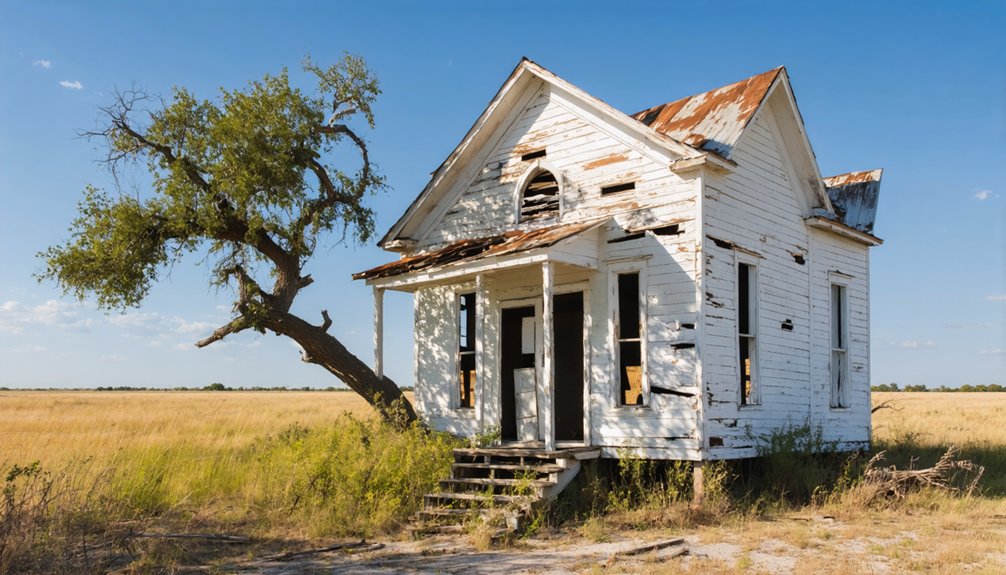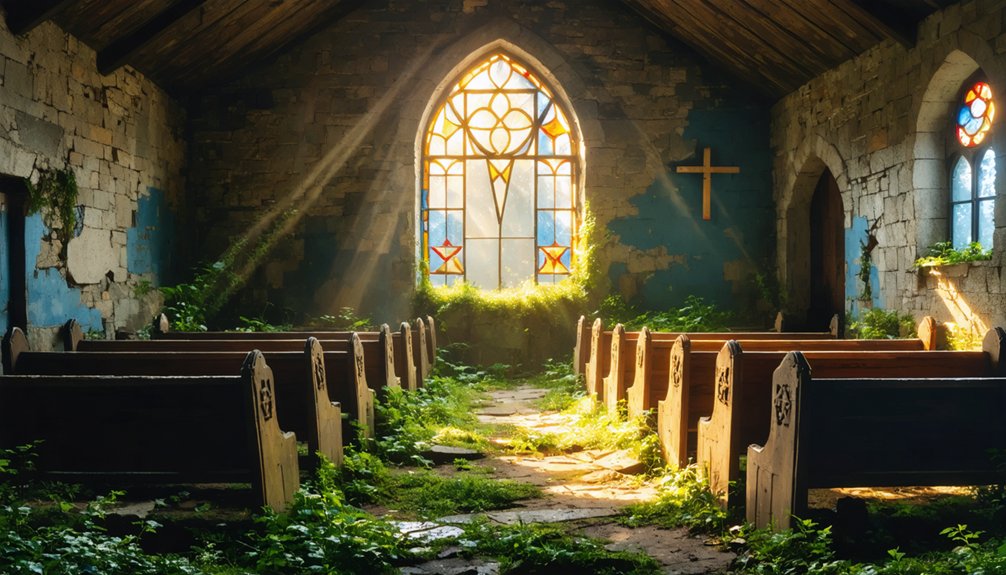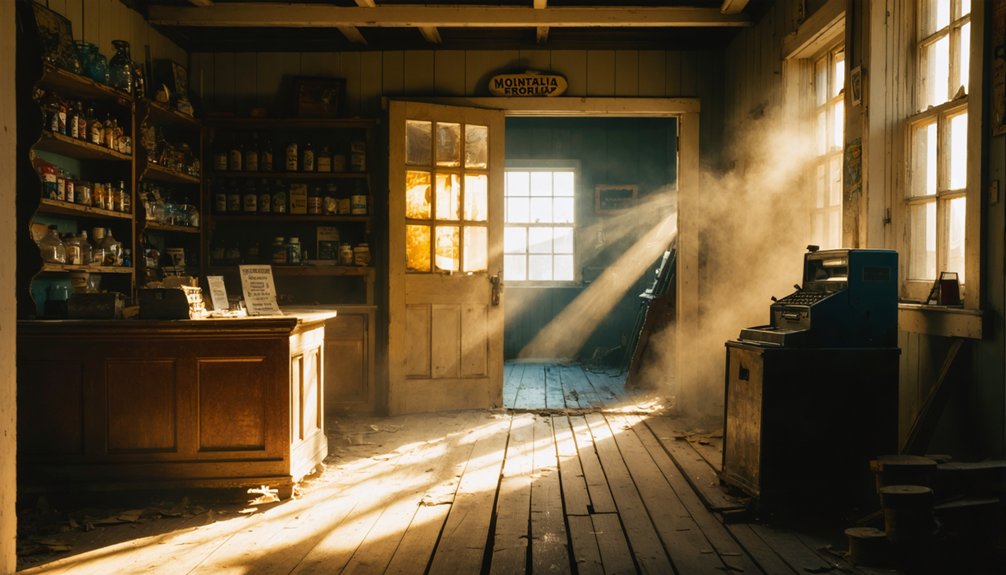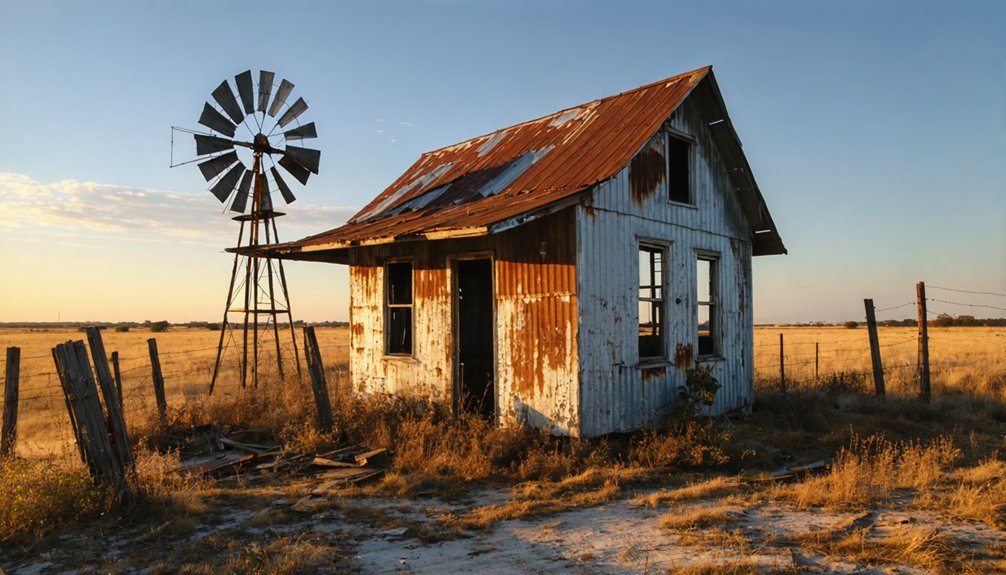You’ll find Monthalia as a ghost town in Gonzales County, Texas, where settlers first arrived in the mid-1840s seeking ranching opportunities near the Guadalupe River. The community thrived through agriculture, multiple religious denominations, and cattle operations until its decline began with the school’s closure in 1948 and post office’s end in 1968. Today, Victorian homes and religious cemeteries stand as silent witnesses to this once-vibrant frontier settlement’s rich cultural heritage.
Key Takeaways
- Monthalia became a ghost town after its post office closed in 1968 and school closed in 1948, marking critical turning points.
- The town’s economy relied heavily on agriculture and ranching, with cotton farming transitioning to livestock operations over time.
- Victorian homes and multiple religious cemeteries remain as historical landmarks, preserving Monthalia’s architectural and cultural heritage.
- Located along the Texas Independence Trail, Monthalia serves as a cultural waypoint representing early Texas frontier settlement.
- Economic decline led to plummeting housing values, high vacancy rates, and limited infrastructure maintenance, contributing to the town’s abandonment.
Early Settlement and Origins in Gonzales County
While Texas was experiencing westward expansion in the mid-1840s, settlers began establishing the community of Monthalia in Gonzales County.
You’ll find that these early pioneers were drawn to the area’s promising ranching opportunities and available land, setting up their homesteads near the life-giving Guadalupe River.
The settlers took advantage of the rich Texas Claypan Prairie soil that characterized the region’s terrain. The settlement patterns of Monthalia’s first residents were heavily influenced by security concerns, as both Native American and Mexican incursions shaped how the community developed.
Despite these challenges, the settlers forged ahead in building their community identity through agricultural and ranching pursuits.
Pioneers persevered through adversity, cultivating both the land and a shared identity as they built their farming community.
The location’s proximity to water resources proved essential for their survival and economic activities, cementing Monthalia’s place in the rural landscape of Gonzales County during this formative period.
Today, visitors can reach the historic site by taking Farm Road 466, which connects to major highways in the region.
Religious Diversity and Sacred Grounds
Beyond the agricultural foundations of early Monthalia, religious institutions formed the bedrock of community life by 1868.
You’ll find evidence of this in the establishment of multiple denominations, including Catholic and Methodist congregations, each maintaining their own sacred grounds and religious architecture. A Masonic lodge operated alongside these churches, adding to the town’s spiritual diversity. Like the crossing business that established Plemons, these religious institutions helped anchor the early settlement.
Community gatherings centered around these religious spaces, where periodic church services and fraternal meetings strengthened social bonds. Similar to the Sagrado Corazon church in Shafter, these places of worship served as moral centers for their local communities.
Today, the town’s denominational cemeteries stand as enduring markers of this religious plurality. While the active congregations have disappeared, these sacred grounds preserve vital insights into Monthalia’s pioneering spirit and cultural heritage, mirroring patterns seen in other Texas ghost towns where religious sites often remain as primary historical remnants.
Agricultural Heritage and Rural Life
During Monthalia’s peak years, agriculture formed the economic backbone of this rural Texas community, with cotton cultivation leading the way until the mid-20th century.
Agricultural practices centered around tenant farming, with two-thirds of farmers working rented land by 1930. You’d find families, including children, laboring in cotton fields during harvest season. The 1846 settlement date marked the beginning of farming activities in the region.
As rural traditions evolved, you’ll notice how mechanization and economic shifts transformed Monthalia’s landscape. Cotton’s dominance gave way to livestock ranching, with Nolan Ryan Beef now operating local cattle operations.
The community adapted by diversifying into poultry production, becoming one of Texas’ leading broiler producers by 1945. Farmers also supplemented their income with specialty crops like pecans and tomatoes, while communal sugarcane processing reflected the tight-knit nature of rural life.
The Town’s Peak Years
During its peak years around 2000, you’d find Monthalia at its most populous with approximately 150 residents, most of whom were engaged in livestock ranching and agricultural trade.
Similar to Texas agricultural areas like Hereford that produce over 1 billion pounds of grain annually, Monthalia’s economy relied heavily on its farming output.
You could observe the town’s strong religious foundations through its established church and masonic lodge dating back to 1868, along with multiple denominational cemeteries that served the community’s diverse spiritual needs.
As you’d explore the town during this era, you’d discover a functioning post office, an active school, and a close-knit farming community that maintained its rural character despite its modest growth. Like many Texas settlements that experienced economic fluctuations, Monthalia’s prosperity was closely tied to the success of its agricultural endeavors.
Agricultural Growth and Trade
As Monthalia established itself in 1846, the town’s economy centered primarily around livestock ranching, particularly cattle operations.
Similar to many of Texas’s 511 ghost towns, Monthalia’s growth was tied to the westward expansion of agriculture and trade during the 1800s.
The trade dynamics evolved around strategic transport routes, including Gonzales County Road 143 and Farm Road 466, connecting ranchers to broader Texas markets.
You’ll find that agricultural innovation emerged through diversification, as farmers adapted to changing economic conditions.
Key developments that shaped Monthalia’s agricultural landscape:
- Nolan Ryan Beef maintained significant cattle operations, continuing the region’s ranching legacy.
- The local post office’s establishment in 1893 facilitated crucial agricultural commerce.
- During the Great Depression, farmers expanded into truck crops, pecans, and poultry to sustain their livelihoods.
The Guadalupe River provided natural resources while nearby Gonzales served as a commercial hub, strengthening the region’s agricultural trade network.
Religious Community Development
While Monthalia remained a small frontier settlement, its religious institutions formed the backbone of community life starting in 1868 with the establishment of its first church and Masonic lodge.
You’ll find evidence of a diverse religious landscape in the separate Catholic and Methodist cemeteries, marking an unusual level of denominational plurality for a frontier town.
The church served as more than just a place of worship – it provided moral guidance through regular services and hosted community gatherings like town potlucks.
Religious organizations supported early educational initiatives and worked alongside civic institutions including the school and post office.
Much like in Goliad where Father Hidalgo’s influence shaped religious life, Monthalia’s churches played a pivotal role in the town’s development.
Though Monthalia’s institutional significance declined with the closure of its school in 1948 and post office in 1968, the remaining religious structures and cemeteries continue drawing visitors interested in the town’s spiritual heritage.
Population at Its Height
The exact peak population of Monthalia remains undocumented in historical records, though evidence suggests a modest frontier settlement sustained primarily by ranching families. Like many semi-abandoned Texas towns, Monthalia experienced a gradual decline in residents over time.
You’ll find demographic stability was maintained through livestock operations, with community cohesion strengthened by the establishment of a church and masonic lodge by 1868.
Three key indicators of the town’s peak period:
- The presence of a functioning post office from 1893, reflecting sufficient population to warrant federal postal service
- A multi-generational community dating back to 1846, with established social institutions
- Integration into the broader Gonzales County economy, which peaked between 28,000-29,000 residents from 1900-1930s
Transportation Challenges and Isolation
Severe transportation limitations played a pivotal role in Monthalia’s decline and isolation, with Farm Road 466 serving as the primary access point to this remote Texas community.
The isolation of Monthalia shows how a single rural road can shape the fate of an entire community.
The limited transportation infrastructure restricted your ability to reach major highways, as you’d need to connect through nearby towns like Cost and Gonzales to access Texas Highway 97 or US Highway 183.
You’ll find community isolation intensified by the unpaved and low-grade roads, which hindered commercial transport and complicated travel during adverse weather.
The lack of public transit options forced reliance on personal vehicles, while the 1968 closure of the post office meant you’d need to travel to Cost for basic services.
The surrounding ranch lands and few neighboring settlements created a physical barrier that further restricted economic opportunities and access to essential services.
Decline and Abandonment

As you examine Monthalia’s economic decline, you’ll find the closure of essential institutions like the post office in 1968 and school in 1948 marked critical turning points in the town’s abandonment.
The absence of rail connections and major highway access isolated Monthalia from regional commerce, contributing to its transformation from a settled community into primarily ranch land.
Economic Forces Behind Exodus
Once thriving on oil production and agriculture, Monthalia’s economic foundation crumbled under multiple devastating forces that ultimately led to its abandonment.
The town’s lack of economic diversification left it vulnerable when both industries declined simultaneously. You would’ve witnessed the devastating impact as oil prices plummeted and agricultural technology advances reduced labor needs, triggering a mass exodus of workers.
- Housing values plunged over 35% in just a few years, with foreclosure rates jumping 40%
- Vacancy rates soared above 20% as transient workers fled
- Local businesses shuttered as consumer spending dried up, destroying community resilience
The town’s dependence on volatile industries proved fatal. Without alternative economic sectors or infrastructure to support change, Monthalia couldn’t adapt to changing market conditions, sealing its fate as another Texas ghost town.
Transportation Network Failures
Transportation infrastructure played a decisive role in Monthalia’s decline, particularly due to its isolation from major transit arteries. You’ll find the town situated on Farm Road 466, a simple two-wheel drive road that couldn’t support heavy commercial traffic.
Without railroad access or major highways, Monthalia’s transportation limitations severely restricted its economic potential.
The closure of key facilities in the mid-20th century further weakened the town’s transportation network. When the post office relocated to Cost in 1968 and the school closed in 1948, the need for maintained roads diminished.
These transportation limitations led to economic isolation, as nearby towns with better infrastructure drew residents and businesses away. Communities like Gonzales and Cost, connected by US highways and rail lines, proved more attractive for both commerce and settlement.
Notable Remaining Structures
While Monthalia has largely faded into Texas history, several structures remain as evidence to its past.
You’ll find the community architecture now centers primarily on residential houses and ranch facilities, with modern ranching operations like Nolan Ryan Beef maintaining active livestock facilities.
The area’s cemetery preservation efforts showcase multiple denominational burial grounds, featuring 19th-century tombstones that reflect the town’s diverse religious heritage since 1846.
Sacred markers in Monthalia’s cemeteries stand as stone testaments to its religious diversity, preserving stories from 1846 onward.
- The cemeteries stand as the most well-maintained historical markers, telling stories of Methodist and Catholic settlers who built this community.
- Ranch buildings, including barns and corrals, represent the enduring spirit of Texas cattle culture.
- Modest residential structures persist, offering glimpses into the daily lives of early Monthalia settlers.
The Legacy of Multiple Faith Communities

You’ll find evidence of Monthalia’s religious diversity in the multiple denomination-specific cemeteries that still stand today, including both Catholic and Methodist burial grounds.
The presence of these sacred spaces, along with the historic church and masonic lodge, reveals how faith communities were central to the town’s social fabric and development.
These faith-based settlement patterns shaped Monthalia’s growth through organized religious activities and communal gatherings, even as the town’s population declined in later years.
Religious Diversity Despite Size
Despite its diminutive size, Monthalia maintained a remarkably diverse religious landscape from its earliest days, with multiple faith communities coexisting within the small settlement.
This cultural exchange was evident in the town’s physical layout, featuring separate Catholic and Methodist cemeteries alongside a church and Masonic lodge established by 1868.
Even as the population dwindled to just 65 residents by 2000, the community’s religious heritage endured.
- You’ll find evidence of community resilience in the way religious gatherings doubled as social events, with services often combining worship and communal meals.
- You can observe how working-class residents prioritized faith, funding and maintaining their own religious structures.
- You’ll notice how the town’s religious diversity survived institutional closures, with sacred spaces outlasting both the school and post office.
Sacred Spaces Still Stand
Three prominent sacred spaces continue to define Monthalia’s religious legacy today: the historic 1868 church, multiple denominational cemeteries, and the Masonic lodge.
The sacred architecture of these structures reflects the craftsmanship and devotion of early settlers who established diverse faith practices in this small Texas community.
Though the town’s population has dwindled, these sacred spaces remain active gathering points.
You’ll find monthly masses combined with community potlucks, while the cemeteries serve as carefully maintained monuments to Catholic, Methodist, and other denominations that once thrived here.
Local historians and descendants work to preserve these sites, which contain distinctive religious iconography and inscriptions.
The buildings’ dual purpose as social centers demonstrates how faith communities adapted to maintain spiritual connections despite demographic changes.
Faith-Based Settlement Patterns
The religious fabric of Monthalia took shape through distinct faith-based settlement patterns, with the 1868 establishment of its first church marking the beginning of a diverse spiritual landscape.
You’ll find evidence of faith community dynamics in the multiple denominational cemeteries, where Catholics and Methodists maintained separate burial grounds, reflecting the town’s religious plurality.
The settlement’s religious interaction patterns centered around multipurpose institutions that served both spiritual and practical needs.
- Churches and Masonic lodges became essential community centers, integrating worship with education and social gatherings.
- Faith-based institutions maintained moral order during frontier challenges, including Apache raids.
- Religious communities preserved their distinct identities while coexisting, creating a sustainable model of rural pluralism.
Regional Impact and Historical Context

Situated within a cluster of small settlements near Gonzales, Texas, Monthalia played a distinctive role in shaping regional settlement patterns during its active years.
You’ll find its legacy intertwined with nearby ghost towns like Nickel, Cheapside, and Dewville, contributing to the area’s rich cultural memory along the Texas Independence Trail.
The town’s strategic location near Farm Road 466 positioned it as a crucial link in local commerce and travel networks.
Monthalia’s significance extended beyond its boundaries through its connection to historic ranching operations, including the renowned Capote Ranch that supplied horses to Teddy Roosevelt’s Rough Riders.
The town’s diverse religious cemeteries reflect the pluralistic nature of early Texas settlements, while its eventual decline mirrors the fate of many small communities bypassed by advancing transportation networks.
Preservation Status and Modern Significance
While most of Monthalia’s original infrastructure has vanished, several Victorian homes and denominational cemeteries stand as preserved monuments to this ghost town’s historical legacy.
You’ll find Monthalia along the Texas Independence Trail, where it serves as a cultural waypoint representing 19th-century rural Texan life. Despite significant preservation challenges, including limited population and resources, the community maintains its historical identity.
- The town’s multiple religious cemeteries showcase the social diversity that once thrived in this small rural settlement.
- Victorian residences, maintained through private ownership, reflect the architectural heritage of early Texas.
- The area’s cultural significance continues through its connection to regional ranching operations and nearby historical attractions in Gonzales.
Frequently Asked Questions
Are There Any Local Legends or Ghost Stories Associated With Monthalia?
You won’t find documented ghostly apparitions or haunted landmarks in Monthalia. Unlike other Texas ghost towns, it lacks specific supernatural stories, though nearby cemeteries contribute to the region’s general folkloric atmosphere.
What Was the Maximum Recorded Population of Monthalia at Its Peak?
You’ll find that during its peak period of population growth around 1892, the town reached approximately 150 residents, marking its historical significance as a once-thriving rural Texas community.
Did Any Famous Historical Figures Ever Visit or Live in Monthalia?
Drawing a blank won’t help here – you won’t find any famous visitors in Monthalia’s history books. Historical records and research don’t show any prominent figures ever living in or stopping by this settlement.
What Natural Disasters, if Any, Contributed to Monthalia’s Abandonment?
You won’t find evidence of flood damage or drought impact contributing to Monthalia’s decline. Historical records don’t indicate any natural disasters played a role in the town’s gradual abandonment.
Are There Any Annual Events or Gatherings Still Held at Monthalia?
You won’t find any documented annual gatherings or community celebrations in Monthalia today. The ghost town’s limited population and infrastructure don’t support regular public events in this historic locale.
References
- https://texashighways.com/travel-news/four-texas-ghost-towns/
- https://cedarbayoumarina.com/four-ghost-towns-under-lake-texoma/
- https://en.wikipedia.org/wiki/List_of_ghost_towns_in_Texas
- https://www.ghosttowns.com/states/tx/monthalia.html
- https://www.youtube.com/watch?v=i-klJP-djSs
- https://mix931fm.com/texas-ghost-towns-history/
- https://www.tshaonline.org/handbook/entries/monthalia-tx
- https://www.texasescapes.com/CentralTexasTownsSouth/Monthalia-Texas.htm
- https://www.tshaonline.org/handbook/entries/gonzales-county
- https://discovertexasoutdoors.com/places/monthalia-texas-a-small-community-keeping-its-ranching-roots-alive/



